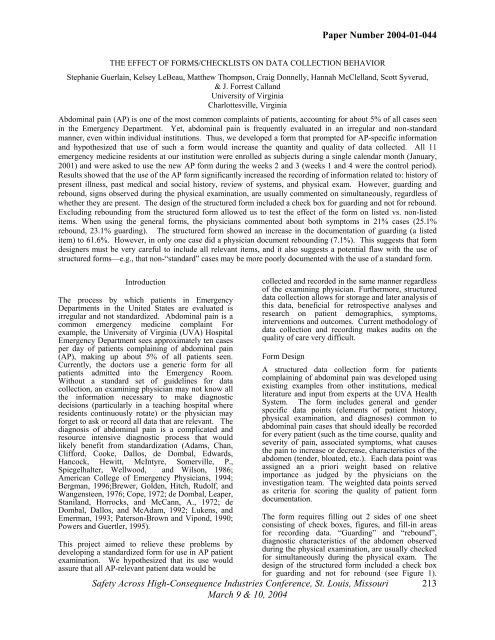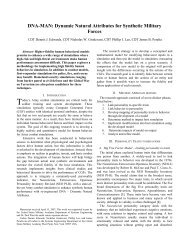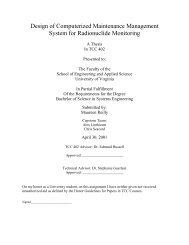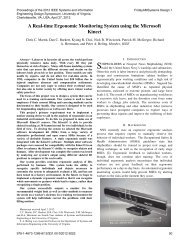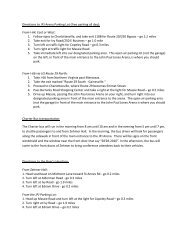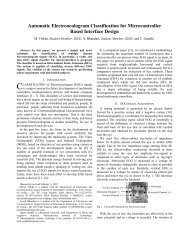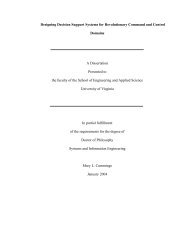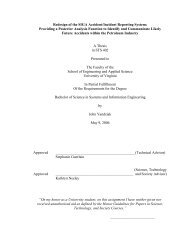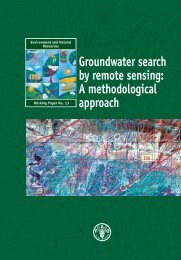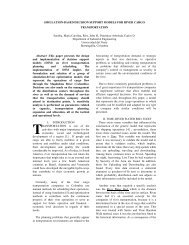The effect of forms/checklists on data collection behavior
The effect of forms/checklists on data collection behavior
The effect of forms/checklists on data collection behavior
Create successful ePaper yourself
Turn your PDF publications into a flip-book with our unique Google optimized e-Paper software.
Paper Number 2004-01-044<br />
THE EFFECT OF FORMS/CHECKLISTS ON DATA COLLECTION BEHAVIOR<br />
Stephanie Guerlain, Kelsey LeBeau, Matthew Thomps<strong>on</strong>, Craig D<strong>on</strong>nelly, Hannah McClelland, Scott Syverud,<br />
& J. Forrest Calland<br />
University <str<strong>on</strong>g>of</str<strong>on</strong>g> Virginia<br />
Charlottesville, Virginia<br />
Abdominal pain (AP) is <strong>on</strong>e <str<strong>on</strong>g>of</str<strong>on</strong>g> the most comm<strong>on</strong> complaints <str<strong>on</strong>g>of</str<strong>on</strong>g> patients, accounting for about 5% <str<strong>on</strong>g>of</str<strong>on</strong>g> all cases seen<br />
in the Emergency Department. Yet, abdominal pain is frequently evaluated in an irregular and n<strong>on</strong>-standard<br />
manner, even within individual instituti<strong>on</strong>s. Thus, we developed a form that prompted for AP-specific informati<strong>on</strong><br />
and hypothesized that use <str<strong>on</strong>g>of</str<strong>on</strong>g> such a form would increase the quantity and quality <str<strong>on</strong>g>of</str<strong>on</strong>g> <strong>data</strong> collected. All 11<br />
emergency medicine residents at our instituti<strong>on</strong> were enrolled as subjects during a single calendar m<strong>on</strong>th (January,<br />
2001) and were asked to use the new AP form during the weeks 2 and 3 (weeks 1 and 4 were the c<strong>on</strong>trol period).<br />
Results showed that the use <str<strong>on</strong>g>of</str<strong>on</strong>g> the AP form significantly increased the recording <str<strong>on</strong>g>of</str<strong>on</strong>g> informati<strong>on</strong> related to: history <str<strong>on</strong>g>of</str<strong>on</strong>g><br />
present illness, past medical and social history, review <str<strong>on</strong>g>of</str<strong>on</strong>g> systems, and physical exam. However, guarding and<br />
rebound, signs observed during the physical examinati<strong>on</strong>, are usually commented <strong>on</strong> simultaneously, regardless <str<strong>on</strong>g>of</str<strong>on</strong>g><br />
whether they are present. <str<strong>on</strong>g>The</str<strong>on</strong>g> design <str<strong>on</strong>g>of</str<strong>on</strong>g> the structured form included a check box for guarding and not for rebound.<br />
Excluding rebounding from the structured form allowed us to test the <str<strong>on</strong>g>effect</str<strong>on</strong>g> <str<strong>on</strong>g>of</str<strong>on</strong>g> the form <strong>on</strong> listed vs. n<strong>on</strong>-listed<br />
items. When using the general <str<strong>on</strong>g>forms</str<strong>on</strong>g>, the physicians commented about both symptoms in 21% cases (25.1%<br />
rebound, 23.1% guarding). <str<strong>on</strong>g>The</str<strong>on</strong>g> structured form showed an increase in the documentati<strong>on</strong> <str<strong>on</strong>g>of</str<strong>on</strong>g> guarding (a listed<br />
item) to 61.6%. However, in <strong>on</strong>ly <strong>on</strong>e case did a physician document rebounding (7.1%). This suggests that form<br />
designers must be very careful to include all relevant items, and it also suggests a potential flaw with the use <str<strong>on</strong>g>of</str<strong>on</strong>g><br />
structured <str<strong>on</strong>g>forms</str<strong>on</strong>g>—e.g., that n<strong>on</strong>-“standard” cases may be more poorly documented with the use <str<strong>on</strong>g>of</str<strong>on</strong>g> a standard form.<br />
Introducti<strong>on</strong><br />
<str<strong>on</strong>g>The</str<strong>on</strong>g> process by which patients in Emergency<br />
Departments in the United States are evaluated is<br />
irregular and not standardized. Abdominal pain is a<br />
comm<strong>on</strong> emergency medicine complaint For<br />
example, the University <str<strong>on</strong>g>of</str<strong>on</strong>g> Virginia (UVA) Hospital<br />
Emergency Department sees approximately ten cases<br />
per day <str<strong>on</strong>g>of</str<strong>on</strong>g> patients complaining <str<strong>on</strong>g>of</str<strong>on</strong>g> abdominal pain<br />
(AP), making up about 5% <str<strong>on</strong>g>of</str<strong>on</strong>g> all patients seen.<br />
Currently, the doctors use a generic form for all<br />
patients admitted into the Emergency Room.<br />
Without a standard set <str<strong>on</strong>g>of</str<strong>on</strong>g> guidelines for <strong>data</strong><br />
collecti<strong>on</strong>, an examining physician may not know all<br />
the informati<strong>on</strong> necessary to make diagnostic<br />
decisi<strong>on</strong>s (particularly in a teaching hospital where<br />
residents c<strong>on</strong>tinuously rotate) or the physician may<br />
forget to ask or record all <strong>data</strong> that are relevant. <str<strong>on</strong>g>The</str<strong>on</strong>g><br />
diagnosis <str<strong>on</strong>g>of</str<strong>on</strong>g> abdominal pain is a complicated and<br />
resource intensive diagnostic process that would<br />
likely benefit from standardizati<strong>on</strong> (Adams, Chan,<br />
Clifford, Cooke, Dallos, de Dombal, Edwards,<br />
Hancock, Hewitt, McIntyre, Somerville, P.,<br />
Spiegelhalter, Wellwood, and Wils<strong>on</strong>, 1986;<br />
American College <str<strong>on</strong>g>of</str<strong>on</strong>g> Emergency Physicians, 1994;<br />
Bergman, 1996;Brewer, Golden, Hitch, Rudolf, and<br />
Wangensteen, 1976; Cope, 1972; de Dombal, Leaper,<br />
Staniland, Horrocks, and McCann, A., 1972; de<br />
Dombal, Dallos, and McAdam, 1992; Lukens, and<br />
Emerman, 1993; Paters<strong>on</strong>-Brown and Vip<strong>on</strong>d, 1990;<br />
Powers and Guertler, 1995).<br />
collected and recorded in the same manner regardless<br />
<str<strong>on</strong>g>of</str<strong>on</strong>g> the examining physician. Furthermore, structured<br />
<strong>data</strong> collecti<strong>on</strong> allows for storage and later analysis <str<strong>on</strong>g>of</str<strong>on</strong>g><br />
this <strong>data</strong>, beneficial for retrospective analyses and<br />
research <strong>on</strong> patient demographics, symptoms,<br />
interventi<strong>on</strong>s and outcomes. Current methodology <str<strong>on</strong>g>of</str<strong>on</strong>g><br />
<strong>data</strong> collecti<strong>on</strong> and recording makes audits <strong>on</strong> the<br />
quality <str<strong>on</strong>g>of</str<strong>on</strong>g> care very difficult.<br />
Form Design<br />
A structured <strong>data</strong> collecti<strong>on</strong> form for patients<br />
complaining <str<strong>on</strong>g>of</str<strong>on</strong>g> abdominal pain was developed using<br />
existing examples from other instituti<strong>on</strong>s, medical<br />
literature and input from experts at the UVA Health<br />
System. <str<strong>on</strong>g>The</str<strong>on</strong>g> form includes general and gender<br />
specific <strong>data</strong> points (elements <str<strong>on</strong>g>of</str<strong>on</strong>g> patient history,<br />
physical examinati<strong>on</strong>, and diagnoses) comm<strong>on</strong> to<br />
abdominal pain cases that should ideally be recorded<br />
for every patient (such as the time course, quality and<br />
severity <str<strong>on</strong>g>of</str<strong>on</strong>g> pain, associated symptoms, what causes<br />
the pain to increase or decrease, characteristics <str<strong>on</strong>g>of</str<strong>on</strong>g> the<br />
abdomen (tender, bloated, etc.). Each <strong>data</strong> point was<br />
assigned an a priori weight based <strong>on</strong> relative<br />
importance as judged by the physicians <strong>on</strong> the<br />
investigati<strong>on</strong> team. <str<strong>on</strong>g>The</str<strong>on</strong>g> weighted <strong>data</strong> points served<br />
as criteria for scoring the quality <str<strong>on</strong>g>of</str<strong>on</strong>g> patient form<br />
documentati<strong>on</strong>.<br />
<str<strong>on</strong>g>The</str<strong>on</strong>g> form requires filling out 2 sides <str<strong>on</strong>g>of</str<strong>on</strong>g> <strong>on</strong>e sheet<br />
c<strong>on</strong>sisting <str<strong>on</strong>g>of</str<strong>on</strong>g> check boxes, figures, and fill-in areas<br />
for recording <strong>data</strong>. “Guarding” and “rebound”,<br />
This project aimed to relieve these problems by diagnostic characteristics <str<strong>on</strong>g>of</str<strong>on</strong>g> the abdomen observed<br />
developing a standardized form for use in AP patient<br />
during the physical examinati<strong>on</strong>, are usually checked<br />
examinati<strong>on</strong>. We hypothesized that its use would<br />
for simultaneously during the physical exam. <str<strong>on</strong>g>The</str<strong>on</strong>g><br />
assure that all AP-relevant patient <strong>data</strong> would be<br />
design <str<strong>on</strong>g>of</str<strong>on</strong>g> the structured form included a check box<br />
for guarding and not for rebound (see Figure 1).<br />
Safety Across High-C<strong>on</strong>sequence Industries C<strong>on</strong>ference, St. Louis, Missouri 213<br />
March 9 & 10, 2004
Paper Number 2004-01-044<br />
Excluding rebounding from the structured form<br />
allowed us to test the <str<strong>on</strong>g>effect</str<strong>on</strong>g> <str<strong>on</strong>g>of</str<strong>on</strong>g> the form <strong>on</strong> listed vs.<br />
n<strong>on</strong>-listed items.<br />
Methods<br />
<str<strong>on</strong>g>The</str<strong>on</strong>g> clinical experiment took place in the University<br />
<str<strong>on</strong>g>of</str<strong>on</strong>g> Virginia Emergency Department. <str<strong>on</strong>g>The</str<strong>on</strong>g> experiment<br />
restricted the participating physicians to emergency<br />
medicine residents to minimize the <str<strong>on</strong>g>effect</str<strong>on</strong>g> <str<strong>on</strong>g>of</str<strong>on</strong>g> a<br />
learning curve experienced by the n<strong>on</strong>-emergency<br />
medicine residents <strong>on</strong> an emergency medicine<br />
rotati<strong>on</strong>. <str<strong>on</strong>g>The</str<strong>on</strong>g> <strong>on</strong>e-m<strong>on</strong>th time period was the<br />
maximum time allowable without the threat <str<strong>on</strong>g>of</str<strong>on</strong>g><br />
inc<strong>on</strong>sistencies associated with the m<strong>on</strong>thly rotati<strong>on</strong><br />
schedules <str<strong>on</strong>g>of</str<strong>on</strong>g> the emergency medicine residents.<br />
We performed the study from January 3 rd to January<br />
30 th , 2001. <str<strong>on</strong>g>The</str<strong>on</strong>g> experiment was comprised <str<strong>on</strong>g>of</str<strong>on</strong>g> three<br />
specific periods. A <strong>on</strong>e-week baseline evaluati<strong>on</strong><br />
period served as the c<strong>on</strong>trol period from which<br />
changes in patient <strong>data</strong> documentati<strong>on</strong> was compared.<br />
In this phase, the emergency medicine residents used<br />
the generic University <str<strong>on</strong>g>of</str<strong>on</strong>g> Virginia Health System<br />
Emergency Room Record as they were accustomed<br />
to doing. During the two-week trial period that<br />
followed the baseline period, the emergency<br />
medicine residents were instructed to use the<br />
structured form instead <str<strong>on</strong>g>of</str<strong>on</strong>g> the generic form for n<strong>on</strong>traumatic<br />
adults (18 years and older) complaining <str<strong>on</strong>g>of</str<strong>on</strong>g><br />
abdominal pain. <str<strong>on</strong>g>The</str<strong>on</strong>g> final week, the reevaluati<strong>on</strong><br />
period, marked crossover change in the<br />
documentati<strong>on</strong> <str<strong>on</strong>g>of</str<strong>on</strong>g> the general form as a result <str<strong>on</strong>g>of</str<strong>on</strong>g><br />
experience with the structured form.<br />
Two teams comprised <str<strong>on</strong>g>of</str<strong>on</strong>g> two members each scored<br />
all <str<strong>on</strong>g>of</str<strong>on</strong>g> the charts for patients admitted into the<br />
Emergency Department complaining <str<strong>on</strong>g>of</str<strong>on</strong>g> abdominal<br />
pain. Both teams graded all <str<strong>on</strong>g>of</str<strong>on</strong>g> the residents’ charts to<br />
ensure accuracy and inter-rater reliability was<br />
measured to ensure c<strong>on</strong>sistency.<br />
Figure 1. Part <str<strong>on</strong>g>of</str<strong>on</strong>g> the abdominal-pain-specific form, where <strong>on</strong>ly <strong>on</strong>e (guarding) <str<strong>on</strong>g>of</str<strong>on</strong>g> two comm<strong>on</strong>ly associated<br />
symptoms (guarding and rebound) are listed.<br />
Safety Across High-C<strong>on</strong>sequence Industries C<strong>on</strong>ference, St. Louis, Missouri 214<br />
March 9 & 10, 2004
Paper Number 2004-01-044<br />
Results<br />
Out <str<strong>on</strong>g>of</str<strong>on</strong>g> the 11 residents who participated in the study,<br />
10 saw cases during the study period, and 9<br />
performed at least <strong>on</strong>e examinati<strong>on</strong> using the form.<br />
In all 9 cases, the average score <str<strong>on</strong>g>of</str<strong>on</strong>g> the resident<br />
increased with use <str<strong>on</strong>g>of</str<strong>on</strong>g> the form (see Figure 2).<br />
Resident 1 saw the most dramatic increase in score,<br />
<str<strong>on</strong>g>of</str<strong>on</strong>g> over 170%. Residents 4 and 9 performed the most<br />
examinati<strong>on</strong>s using the form, and saw increases <str<strong>on</strong>g>of</str<strong>on</strong>g><br />
65% and 43%, respectively.<br />
70<br />
60<br />
50<br />
40<br />
30<br />
20<br />
10<br />
0<br />
Comparis<strong>on</strong>s <str<strong>on</strong>g>of</str<strong>on</strong>g> Scores<br />
1 2 3 4 5 6 7 8 9 10<br />
Figure 2 - Average Score by Resident<br />
W/o Form<br />
W/ Form<br />
Table 1 shows the results, comparing all cases<br />
documented with the new form vs. all cases<br />
documented with the generic form. <str<strong>on</strong>g>The</str<strong>on</strong>g>se results<br />
show highly significant improved <strong>data</strong> collecti<strong>on</strong><br />
with the form in the areas <str<strong>on</strong>g>of</str<strong>on</strong>g>: history <str<strong>on</strong>g>of</str<strong>on</strong>g> present<br />
illness, past medical and social history, review <str<strong>on</strong>g>of</str<strong>on</strong>g><br />
systems, and physical exam. <str<strong>on</strong>g>The</str<strong>on</strong>g>re was no<br />
difference between the <str<strong>on</strong>g>forms</str<strong>on</strong>g> <strong>on</strong> documentati<strong>on</strong> <str<strong>on</strong>g>of</str<strong>on</strong>g><br />
diagnostic studies, as would be expected as these<br />
results are typically reported <strong>on</strong> a different form and<br />
not carried over to this type <str<strong>on</strong>g>of</str<strong>on</strong>g> a form. Finally, there<br />
was a significant decrease in the number <str<strong>on</strong>g>of</str<strong>on</strong>g> patients<br />
with recorded sec<strong>on</strong>dary complaints with the use <str<strong>on</strong>g>of</str<strong>on</strong>g><br />
the form, suggesting that it may be difficult to record<br />
multiple chief complaints with this type <str<strong>on</strong>g>of</str<strong>on</strong>g> a form.<br />
Table 1. Scores by Form Use<br />
C<strong>on</strong>trol<br />
(n = 198)<br />
Overall<br />
Adequacy <str<strong>on</strong>g>of</str<strong>on</strong>g> 33.4 +<br />
Data<br />
9.3<br />
Collecti<strong>on</strong> 1<br />
History <str<strong>on</strong>g>of</str<strong>on</strong>g><br />
12.6 +<br />
Present<br />
Illness 1 7.2<br />
Interventi<strong>on</strong><br />
(n=38)<br />
49.7 + 9.7<br />
22.9 + 5.2<br />
Past Medical<br />
and Social 8.6 + 2.3 10.6 + 3.3<br />
History 1<br />
Review <str<strong>on</strong>g>of</str<strong>on</strong>g><br />
Systems 1 4.8 + 3.8 7.7 + 4.8<br />
Physical 20.6 +<br />
Exam 1 7.6<br />
29.6 + 6.0<br />
Diagnostic<br />
Studies 1 6.0 + 6.3 6.0 + 6.7<br />
Documentati<br />
<strong>on</strong> <str<strong>on</strong>g>of</str<strong>on</strong>g> 2º 65% 48%<br />
Complaints 2<br />
1. Two-tailed t-test for independent samples.<br />
2. Chi-square test for independence.<br />
80%<br />
70%<br />
60%<br />
50%<br />
40%<br />
30%<br />
20%<br />
10%<br />
0%<br />
Resident<br />
p-value<br />
P<<br />
0.0000<br />
1<br />
P<<br />
0.0000<br />
1<br />
P<<br />
0.001<br />
P<<br />
0.001<br />
P<<br />
0.0000<br />
1<br />
P =<br />
0.92<br />
P =<br />
0.048<br />
1 2 3 4 5 6 7 8 9 10<br />
Compliance Rate 16. 45. 12. 72. 25. 8.7 0.0 50. 50. 16.<br />
Compliance Rate<br />
Out <str<strong>on</strong>g>of</str<strong>on</strong>g> 116 total cases seen in weeks 2 and 3 (the<br />
testing period), the physicians <strong>on</strong>ly utilized the<br />
template form 38 times, a 35% compliance rate.<br />
<str<strong>on</strong>g>The</str<strong>on</strong>g>re existed a large disparity am<strong>on</strong>g the<br />
compliance rates <str<strong>on</strong>g>of</str<strong>on</strong>g> the individual physicians. Some<br />
had rates as high as 72.2% (Resident 4), whereas<br />
others were as low as 0% (Resident 7). <str<strong>on</strong>g>The</str<strong>on</strong>g>se results<br />
can be seen in Figure 3.<br />
Figure 3 - Resident Compliance Rate<br />
We c<strong>on</strong>ducted a post-study survey to get subjective<br />
opini<strong>on</strong>s <str<strong>on</strong>g>of</str<strong>on</strong>g> the use <str<strong>on</strong>g>of</str<strong>on</strong>g> the form, particularly due to<br />
the low compliance. Results from our survey<br />
showed that the primary reas<strong>on</strong> for not using the<br />
form was forgetfulness. A sec<strong>on</strong>dary reas<strong>on</strong> was the<br />
difficulty <str<strong>on</strong>g>of</str<strong>on</strong>g> using the form for patients with multiple<br />
chief complaints. Thus, the significantly lower<br />
number <str<strong>on</strong>g>of</str<strong>on</strong>g> <str<strong>on</strong>g>forms</str<strong>on</strong>g> that documented sec<strong>on</strong>dary<br />
complaints (see Table 1) may be due to a selfselecting<br />
factor by the subjects, i.e., they chose not to<br />
Safety Across High-C<strong>on</strong>sequence Industries C<strong>on</strong>ference, St. Louis, Missouri 215<br />
March 9 & 10, 2004
Paper Number 2004-01-044<br />
use the form with patients complaining <str<strong>on</strong>g>of</str<strong>on</strong>g> multiple<br />
symptoms.<br />
Although there was a low compliance rate am<strong>on</strong>gst<br />
the residents using the form, when surveyed, 6 out <str<strong>on</strong>g>of</str<strong>on</strong>g><br />
7 <str<strong>on</strong>g>of</str<strong>on</strong>g> the survey resp<strong>on</strong>dents reported “liking” the<br />
form (4 out <str<strong>on</strong>g>of</str<strong>on</strong>g> 5 <strong>on</strong> a 5-point Likert scale) and the 7 th<br />
resp<strong>on</strong>dent was neutral (3 out <str<strong>on</strong>g>of</str<strong>on</strong>g> 5). 100% <str<strong>on</strong>g>of</str<strong>on</strong>g><br />
resp<strong>on</strong>dents thought the form was useful and<br />
<str<strong>on</strong>g>effect</str<strong>on</strong>g>ive in recording standardized and thorough<br />
patient <strong>data</strong>. Six <str<strong>on</strong>g>of</str<strong>on</strong>g> the seven resp<strong>on</strong>dents stated that<br />
the form prompted them to ask the patient for more<br />
informati<strong>on</strong> than they would normally acquire using<br />
the current patient evaluati<strong>on</strong> form. One resident<br />
commented, “<str<strong>on</strong>g>The</str<strong>on</strong>g> form especially aided in thorough<br />
<strong>data</strong> collecti<strong>on</strong> <strong>on</strong> cases I thought were<br />
straightforward.” Furthermore, all <str<strong>on</strong>g>of</str<strong>on</strong>g> the resp<strong>on</strong>dents<br />
believed that standardized <strong>data</strong> collecti<strong>on</strong> was not<br />
<strong>on</strong>ly aided by our form, but was useful for training<br />
purposes and epidemiology studies.<br />
Finally, all <str<strong>on</strong>g>of</str<strong>on</strong>g> the residents stated that the form<br />
became easier to use as they became acquainted with<br />
its format and layout. One resident commented,<br />
“This form has great potential and could become<br />
very valuable in the l<strong>on</strong>g run. I d<strong>on</strong>’t want this form<br />
to be thrown-out because we are using the results<br />
during the “adjustment phase.” Nobody likes to<br />
learn new things.” Another resident stated,<br />
“Following this initial glance, the resident would<br />
need three to five uses to feel completely<br />
comfortable using the form during a patient<br />
examinati<strong>on</strong>.”<br />
Effect <str<strong>on</strong>g>of</str<strong>on</strong>g> Form <strong>on</strong> Data Collected<br />
Guarding and rebound, signs observed during the<br />
physical examinati<strong>on</strong>, are usually commented <strong>on</strong><br />
simultaneously, regardless <str<strong>on</strong>g>of</str<strong>on</strong>g> whether they are<br />
present. <str<strong>on</strong>g>The</str<strong>on</strong>g> design <str<strong>on</strong>g>of</str<strong>on</strong>g> the structured form included<br />
a check box for guarding but not for rebound. When<br />
using the general <str<strong>on</strong>g>forms</str<strong>on</strong>g>, the physicians commented<br />
about both symptoms in 21% cases (25.1% rebound,<br />
23.1% guarding). <str<strong>on</strong>g>The</str<strong>on</strong>g> structured form showed an<br />
increase in the documentati<strong>on</strong> <str<strong>on</strong>g>of</str<strong>on</strong>g> guarding (a listed<br />
item) to 61.6%. However, in <strong>on</strong>ly <strong>on</strong>e case did a<br />
physician document rebounding (7.1%). <str<strong>on</strong>g>The</str<strong>on</strong>g>se<br />
results can be seen in Figure 4.<br />
This suggests that form designers must be very<br />
careful to include all relevant items, and it also<br />
suggests a potential flaw with the use <str<strong>on</strong>g>of</str<strong>on</strong>g> structured<br />
<str<strong>on</strong>g>forms</str<strong>on</strong>g>—e.g., that n<strong>on</strong>-“standard” cases may be more<br />
poorly documented with the use <str<strong>on</strong>g>of</str<strong>on</strong>g> a standard form.<br />
100<br />
80<br />
%<br />
60<br />
40<br />
20<br />
0<br />
Sensitivity <str<strong>on</strong>g>of</str<strong>on</strong>g> Structured Form<br />
25.1<br />
23.3<br />
No Form<br />
Rebound<br />
7.2<br />
Guarding<br />
Form<br />
61.6<br />
Figure 4 Influence <str<strong>on</strong>g>of</str<strong>on</strong>g> form <strong>on</strong> documentati<strong>on</strong> <str<strong>on</strong>g>of</str<strong>on</strong>g><br />
listed vs. n<strong>on</strong>-listed items<br />
C<strong>on</strong>clusi<strong>on</strong><br />
We hypothesized that the use <str<strong>on</strong>g>of</str<strong>on</strong>g> a standardized AP<br />
form would provide for a more complete means <str<strong>on</strong>g>of</str<strong>on</strong>g><br />
<strong>data</strong> collecti<strong>on</strong> and analysis. After determining what<br />
<strong>data</strong> was crucial to diagnostic decisi<strong>on</strong>-making, we<br />
designed and created an AP form to test this<br />
hypothesis. For a two-week period, Emergency<br />
Room residents were asked to use this form as a<br />
substitute for the hospital's current generic form<br />
when performing examinati<strong>on</strong>s <strong>on</strong> patients<br />
complaining <str<strong>on</strong>g>of</str<strong>on</strong>g> abdominal pain. We collected<br />
hospital records <strong>on</strong> all cases <str<strong>on</strong>g>of</str<strong>on</strong>g> AP throughout the<br />
m<strong>on</strong>th <str<strong>on</strong>g>of</str<strong>on</strong>g> January, and recorded all documentati<strong>on</strong><br />
made by the residents. Our group assigned predetermined<br />
scores to certain critical <strong>data</strong> points, and<br />
totaled these to give a score to each case in the study.<br />
To determine the <str<strong>on</strong>g>effect</str<strong>on</strong>g> <str<strong>on</strong>g>of</str<strong>on</strong>g> the AP form, we then<br />
compared the scores based <strong>on</strong> form use.<br />
When residents utilized the AP form, the average<br />
score for those patient encounters was significantly<br />
higher (59%, p
Paper Number 2004-01-044<br />
this area to determine if there is a way to overcome<br />
this potential negative factor.<br />
Years.” American Journal <str<strong>on</strong>g>of</str<strong>on</strong>g> Emergency Medicine.<br />
13(3) p. 301-3.<br />
If these factors can be overcome, based <strong>on</strong> the<br />
significant increase in score dem<strong>on</strong>strated by this<br />
study, we feel a full-scale implementati<strong>on</strong> <str<strong>on</strong>g>of</str<strong>on</strong>g> a<br />
standardized form in the future will significantly aid<br />
the Emergency Room residents in a standardized<br />
<strong>data</strong> collecti<strong>on</strong> process. Further, the warehousing <str<strong>on</strong>g>of</str<strong>on</strong>g><br />
this standardized <strong>data</strong> set will allow for large-scale<br />
retrospective studies <strong>on</strong> patient demographics,<br />
symptoms, treatment protocols and outcomes.<br />
References<br />
Adams, I., Chan, M., Clifford, P., Cooke, W.,<br />
Dallos, V., de Dombal, F., Edwards, M., Hancock,<br />
D. Hewitt, D., McIntyre, N., Somerville, P.,<br />
Spiegelhalter, D., Wellwood, J., and Wils<strong>on</strong>, D.,<br />
(1986). “Computer aided diagnosis <str<strong>on</strong>g>of</str<strong>on</strong>g> acute<br />
abdominal pain: a multicentre study.” British<br />
Medical Journal. 800-804.<br />
American College <str<strong>on</strong>g>of</str<strong>on</strong>g> Emergency Physicians.<br />
(1994). “Clinical Policy for the Initial Approach to<br />
Patients Presenting with a Chief Complaint <str<strong>on</strong>g>of</str<strong>on</strong>g><br />
N<strong>on</strong>traumatic Acute Abdominal Pain.” Annals <str<strong>on</strong>g>of</str<strong>on</strong>g><br />
Emergency Medicine. 23.4 906-922<br />
Bergman, R. “Assessing Acute Abdominal<br />
Pain: A Team Physician's Challenge”<br />
www.physsportsmed.com/issues/apr_96/bergman.ht<br />
m<br />
Brewer, R., Golden, G., Hitch, C., Rudolf, E.,<br />
and Wangensteen, L. (1976). “Abdominal Pain: An<br />
Analysis <str<strong>on</strong>g>of</str<strong>on</strong>g> 1,000 C<strong>on</strong>secutive Cases in a University<br />
Hospital Emergency Room.” <str<strong>on</strong>g>The</str<strong>on</strong>g> American Journal<br />
<str<strong>on</strong>g>of</str<strong>on</strong>g> Surgery. 13(1) 219-223<br />
Cope, Z. (1972). <str<strong>on</strong>g>The</str<strong>on</strong>g> Early Diagnosis Of <str<strong>on</strong>g>The</str<strong>on</strong>g><br />
Acute Abdomen. 14 th ed. L<strong>on</strong>d<strong>on</strong>: Oxford University<br />
Press.<br />
de Dombal F., Leaper D., Staniland J., Horrocks<br />
J., and McCann A. (1972). “Computer Aided<br />
Diagnosis <str<strong>on</strong>g>of</str<strong>on</strong>g> the Acute Abdomen.” British Medical<br />
Journal, p. 73-75.<br />
de Dombal F., Dallos, V. and McAdam, W.<br />
(1992). “Can Computer Aided teaching Packages<br />
Improve Clinical Care in Patients with Acute<br />
Abdominal Pain?” Yearbook <str<strong>on</strong>g>of</str<strong>on</strong>g> Medical Informati<strong>on</strong>.<br />
p. 286-288.<br />
Lukens, T. and Emerman, C. (1993). “<str<strong>on</strong>g>The</str<strong>on</strong>g><br />
Natural History and Clinical Findings in<br />
Undifferentiated Abdominal Pain.” Annals <str<strong>on</strong>g>of</str<strong>on</strong>g><br />
Emergency Medicine. 22(4) p. 690-696.<br />
Paters<strong>on</strong>-Brown S., and Vip<strong>on</strong>d M. (1990).<br />
“Modern aids to clinical decisi<strong>on</strong>-making in the<br />
acute abdomen.” British Journal <str<strong>on</strong>g>of</str<strong>on</strong>g> Surgery. Vol. 77<br />
No.1. p. 13-17.<br />
Powers, R. and Guertler, A. (1995). “Abdominal<br />
Pain in the ED: Stability and Change Over 20<br />
Safety Across High-C<strong>on</strong>sequence Industries C<strong>on</strong>ference, St. Louis, Missouri 217<br />
March 9 & 10, 2004


